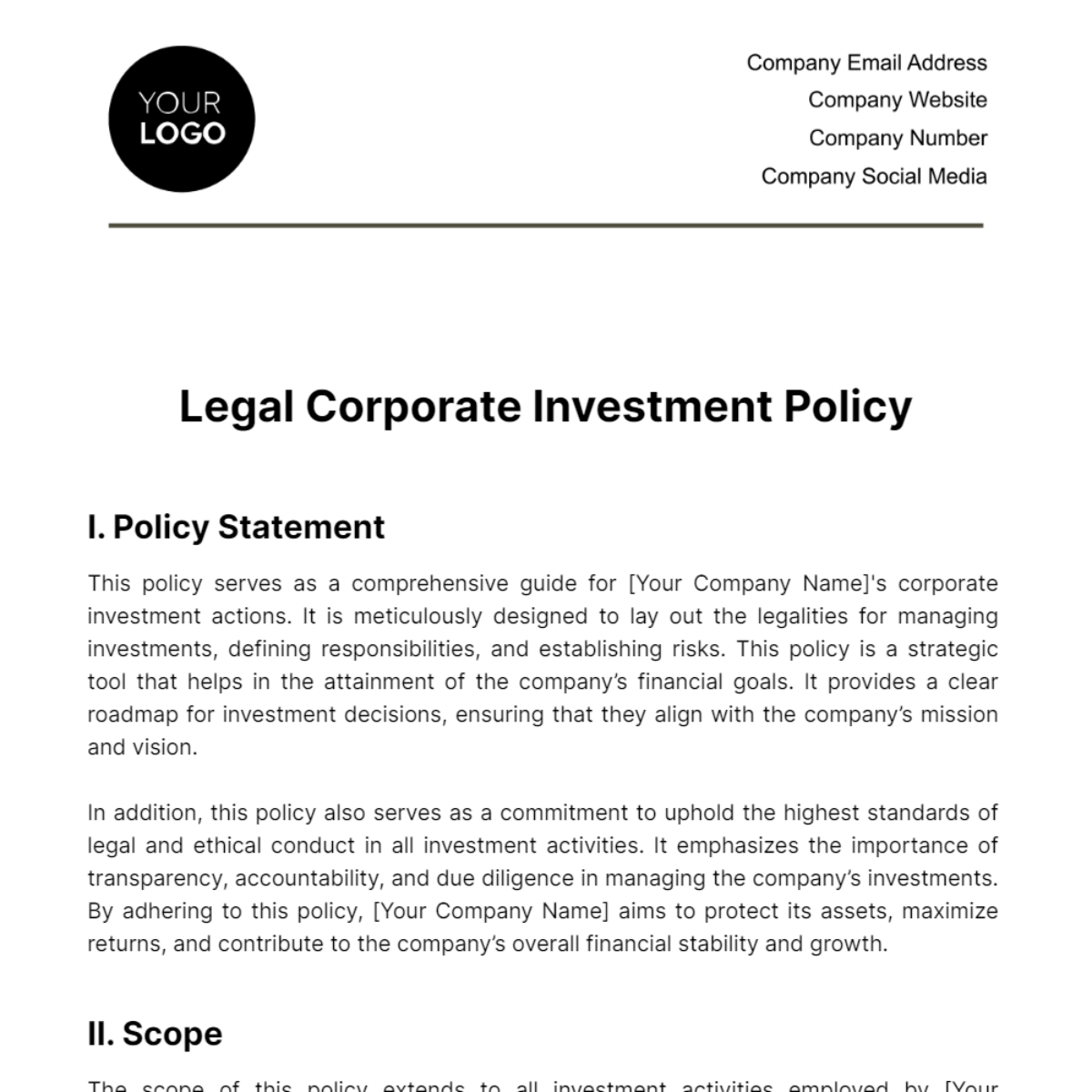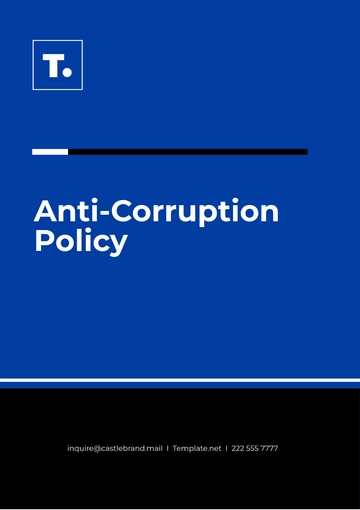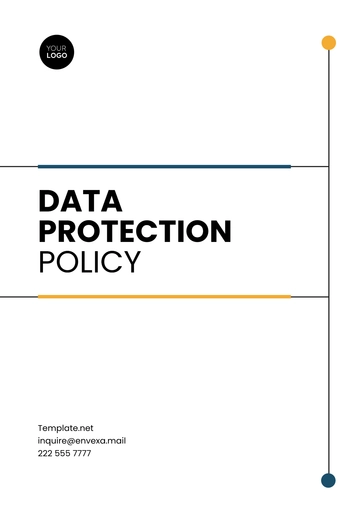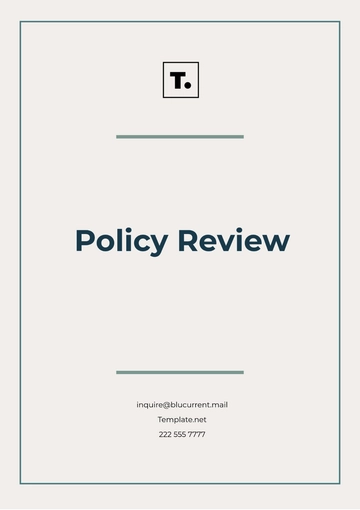Free Legal Corporate Investment Policy

I. Policy Statement
This policy serves as a comprehensive guide for [Your Company Name]'s corporate investment actions. It is meticulously designed to lay out the legalities for managing investments, defining responsibilities, and establishing risks. This policy is a strategic tool that helps in the attainment of the company’s financial goals. It provides a clear roadmap for investment decisions, ensuring that they align with the company’s mission and vision.
In addition, this policy also serves as a commitment to uphold the highest standards of legal and ethical conduct in all investment activities. It emphasizes the importance of transparency, accountability, and due diligence in managing the company’s investments. By adhering to this policy, [Your Company Name] aims to protect its assets, maximize returns, and contribute to the company’s overall financial stability and growth.
II. Scope
The scope of this policy extends to all investment activities employed by [Your Company Name]. It is designed to ensure that all investments made comply with the legal regulatory framework, safeguard the company’s assets, and generate returns beneficial to the company. This includes, but is not limited to, the purchase and sale of stocks, bonds, mutual funds, and other investment vehicles.
A. Applicability
This policy applies to all employees, officers, and directors of [Your Company Name]. It is their responsibility to understand and adhere to the guidelines set forth in this policy. This ensures that all investment decisions are made in the best interest of the company and in compliance with all applicable laws and regulations.
The policy also applies to any third-party acting on behalf of [Your Company Name]. This includes financial advisors, brokers, and other external entities involved in the company’s investment activities. They are expected to uphold the same standards of legal and ethical conduct as defined in this policy.
B. Investment Activities
The policy covers a wide range of investment activities. This includes the acquisition and disposal of financial instruments such as stocks, bonds, and mutual funds. It also covers investments in real estate, private equity, and other alternative investment vehicles.
The policy also governs the use of derivatives for hedging purposes. This includes futures, options, swaps, and other financial contracts that derive their value from underlying assets. The use of derivatives must be in line with the company’s risk management strategy and comply with all applicable laws and regulations.
The policy also outlines the procedures for managing cash and cash equivalents. This includes the placement of deposits with financial institutions, the purchase of treasury bills and other short-term securities, and the management of money market funds. These activities must be conducted in a manner that ensures the company’s liquidity needs are met while earning a reasonable return on idle cash.
III. Investment Objectives
The investment objectives of [Your Company Name] are multifaceted and strategically designed to ensure the financial growth and stability of the company. These objectives are not only aimed at optimizing the return on investments but also at ensuring liquidity and minimizing risks, all while strictly adhering to all applicable regulatory requirements. The investments made by the company should always be in line with and supportive of the strategic goals and operations of the company.
A. Return Optimization
Maximizing Returns: The primary objective of [Your Company Name]'s investment activities is to maximize returns. This involves a careful selection of investments that have the potential for high returns. However, the pursuit of high returns does not mean reckless risk-taking. Every investment decision is made after a thorough analysis of the potential returns against the associated risks. The aim is to strike a balance between risk and return, ensuring that the company’s assets grow steadily over time.
Performance Benchmarking: Regular performance benchmarking is a crucial part of the company’s investment strategy. By comparing the performance of its investments against relevant benchmarks, the company can assess whether its investments are performing as expected and contributing positively to its financial goals. This process of benchmarking provides valuable insights that guide future investment decisions, helping to ensure that the company’s investment portfolio remains robust and profitable.
Regular Review: Regular review of the investment portfolio is another key aspect of the company’s investment strategy. This involves assessing the performance of individual investments and making adjustments as necessary to optimize returns. Regular reviews help the company to identify underperforming investments early and take corrective action, thereby protecting the company’s assets and ensuring the continued growth of its investment portfolio.
B. Liquidity Management
Cash Flow Management: Effective cash flow management is essential to ensure the company’s financial health and stability. The company manages its investments in a way that ensures sufficient liquidity to meet its operating, capital, and strategic needs. This involves careful cash flow forecasting and investing in assets that can be easily converted into cash if needed. By maintaining sufficient liquidity, the company can meet its financial obligations promptly and efficiently, thereby maintaining its financial stability and reputation.
Liquidity Ratio: The company also aims to maintain a healthy liquidity ratio. This ratio, which compares liquid assets to current liabilities, provides a measure of the company’s ability to meet short-term obligations. A healthy liquidity ratio is indicative of the company’s strong financial position and its ability to withstand financial shocks. By maintaining a healthy liquidity ratio, the company ensures that it has sufficient resources to seize investment opportunities as they arise and to meet unexpected expenses.
C. Risk Minimization
Risk Assessment: Risk assessment is a critical component of the company’s investment decision-making process. Before making any investment, the company conducts a thorough risk assessment. This involves analyzing the potential return of the investment in relation to its risk. The aim is to understand the risk-return tradeoff of each investment and to make informed investment decisions that align with the company’s risk tolerance and investment objectives.
Diversification: Diversification is a key strategy used by the company to minimize investment risk. By diversifying its investments across various asset classes, sectors, and regions, the company can reduce the impact of any single investment performing poorly. Diversification helps to spread risk and can enhance the overall performance of the investment portfolio.
Risk Tolerance: All investment decisions made by the company are in line with its risk tolerance. The company’s risk tolerance is determined by factors such as its financial position, its strategic objectives, and the overall economic environment. By understanding its risk tolerance, the company can make investment decisions that are appropriate for its risk appetite and that contribute positively to its financial goals.
IV. Legal and Regulatory Compliance
Legal and regulatory compliance is a fundamental aspect of [Your Company Name]'s investment activities. It is of utmost importance that all investments made by the company comply with applicable laws, regulations, as well as the policy guidelines of the company.
The following table outlines the key legal and regulatory requirements that must be adhered to:
Requirement | Description |
|---|---|
Anti-Money Laundering | Investments must not be used to launder money or support illegal activities. |
Anti-Bribery and Corruption | The company will not engage in or support any form of bribery or corruption. |
Insider Trading | The company will not use non-public, material information to trade securities. |
Compliance plays a crucial role in risk management. It ensures that the company’s investment activities are conducted in a lawful and ethical manner, thereby protecting the company’s reputation and promoting stakeholder trust. It also plays a crucial role in mitigating legal and reputational risks, thereby contributing to the company’s long-term success.
Anti-Money Laundering Laws are designed to prevent the use of financial systems for the illicit conversion of money. Compliance with these laws involves conducting due diligence on investment sources and maintaining robust systems for monitoring and reporting suspicious activities.
Anti-Bribery and Corruption laws prohibit the offering, giving, receiving, or soliciting of anything of value to influence the actions of an official or other person in charge of a public or legal duty. Adherence to these laws requires the company to maintain a culture of integrity and transparency, and to implement effective controls to prevent and detect bribery and corruption.
Insider Trading regulations prohibit the buying or selling of a security by someone who has access to material, nonpublic information about the security. Compliance with these regulations involves maintaining strict controls over the handling of inside information and ensuring that all trading activities are conducted in a fair and transparent manner.
Compliance with these legal and regulatory requirements is not just about avoiding penalties and sanctions. It’s about maintaining the integrity of [Your Company Name] and ensuring the trust of its stakeholders. By adhering to these requirements, the company demonstrates its commitment to ethical business practices.
V. Risk Management
Risk management is an integral part of [Your Company Name]'s investment activities. It involves identifying, assessing, and addressing potential risks that could impact the company’s investment portfolio. The company is committed to maintaining an effective risk management and monitoring process to ensure the stability and growth of its investments.
A. Risk Assessment
Risk Identification: The first step in the risk assessment process is risk identification. This involves understanding the nature of each investment, the market conditions, and the external factors that could impact the investment’s performance.
Risk Analysis: Once the risks have been identified, the company will analyze them to understand their potential impact on the company’s investments. This involves assessing the likelihood of each risk occurring and its potential impact on the investment’s returns. The aim is to gain a comprehensive understanding of the risk landscape to inform decision-making.
Risk Evaluation: After analyzing the risks, the company will evaluate them to determine which risks need to be mitigated. This involves comparing the analyzed risks with the company’s risk tolerance to determine the company’s risk exposure. The risk evaluation process helps the company prioritize its risk mitigation efforts based on the severity and likelihood of the risks.
B. Risk Mitigation
Risk Diversification: One of the key strategies for mitigating investment risk is diversification. By diversifying its investments across various asset classes, sectors, and regions, the company can spread the risk and reduce the impact of any single investment performing poorly. Diversification is a proactive risk management strategy that helps to enhance the overall performance of the investment portfolio.
Risk Transfer: In some cases, the company may choose to transfer the risk to another party. This could involve using financial instruments such as derivatives to hedge against certain risks. Risk transfer is a strategic decision that can help the company manage its risk exposure and protect its financial health.
Risk Avoidance: If a particular risk is too high and cannot be effectively mitigated, the company may choose to avoid it altogether. This could involve not proceeding with a particular investment. Risk avoidance is a defensive strategy that is used when the potential loss from a risk is greater than the potential gain from the investment.
VI. Roles and Responsibilities
The successful implementation and management of [Your Company Name]'s investment activities require the concerted effort of various roles within the organization. The following table outlines the key roles and their responsibilities:
Role | Responsibility |
|---|---|
Board of Directors | Approve the investment policy and any changes to it. |
Chief Executive Officer (CEO) | Ensure the policy is implemented and followed. |
Chief Financial Officer (CFO) | Oversee the company’s investment activities. |
Investment Committee | Make investment decisions within the parameters of the policy. |
The roles and responsibilities outlined in this policy are essential in ensuring the successful implementation of [Your Company Name]'s investment strategy. They ensure that the company’s investment activities are managed in a coordinated and effective manner, thereby contributing to the achievement of the company’s financial goals.
The Board of Directors provides the strategic direction for the company’s investments. They approve the investment policy and any changes to it, ensuring that it aligns with the company’s overall strategic objectives. The Board also provides oversight, ensuring that the policy is implemented effectively and that the company’s investments are managed prudently.
The CEO plays a pivotal role in ensuring that the investment policy is implemented and followed throughout the organization. They work closely with other executives and the Board to align the company’s investment activities with its strategic objectives. The CEO also promotes a culture of compliance and ethical conduct in the company’s investment activities.
The CFO, on the other hand, oversees the company’s investment activities. They ensure that the company’s investments are managed effectively and that they align with the company’s financial goals and risk appetite. The CFO also plays a key role in financial reporting and in communicating the company’s investment performance to the Board and other stakeholders.
The Investment Committee is responsible for making investment decisions within the parameters of the policy. They conduct thorough analyses of potential investments, considering factors such as potential returns, risks, and alignment with the company’s strategic objectives. The Investment Committee also monitors the performance of the company’s investments and makes adjustments as necessary.
The delineation of these roles and responsibilities is not just about ensuring effective management of the company’s investments. It’s also about accountability. By clearly defining who is responsible for what, the company ensures that there is accountability at all levels. This promotes transparency, enhances governance, and ultimately contributes to the company’s long-term success.
VII. Policy Review
A. Annual Review
Review Schedule: The policy will be reviewed at least once a year. This ensures that the policy remains up-to-date and relevant to the company’s current situation and objectives. The annual review is a critical process that helps the company stay aligned with the changing investment landscape and regulatory environment.
Review Process: The review will involve assessing the effectiveness of the policy in guiding the company’s investment activities. This includes reviewing the policy’s objectives, guidelines, and procedures to ensure they are still appropriate and effective. The review process is a comprehensive exercise that involves input from various stakeholders, including the Board of Directors, senior management, and the investment team.
B. Policy Updates
Update Process: If changes to the policy are necessary, they will be approved by the Board of Directors. This ensures that any changes are made in the best interest of the company and its stakeholders. The update process is a rigorous one that involves careful consideration of the potential impact of any changes on the company’s investment activities and financial performance.
Communication of Changes: All employees, officers, and directors will be notified of any changes to the policy. This ensures that everyone is aware of the updated policy and can adhere to it in their investment activities. Effective communication of policy changes is crucial for ensuring compliance and alignment across the organization.
- 100% Customizable, free editor
- Access 1 Million+ Templates, photo’s & graphics
- Download or share as a template
- Click and replace photos, graphics, text, backgrounds
- Resize, crop, AI write & more
- Access advanced editor
Formulate investment policies effectively with the Legal Corporate Investment Policy Template! This fully editable policy provides a versatile solution for customization through the AI Editor Tool. Explore the diverse features of Template.net's customizable resource to easily optimize your corporate investment policies! Make use of our professional and user-friendly platform today!
You may also like
- HR Policy
- Restaurant Policy
- Company Policy
- Accounting Policies and Procedures
- Website Policy
- Privacy Policy
- Safety Policy
- School Policy
- IT and Software Policy
- Law Firm Policy
- Construction Policy
- Interior Design Policy
- Travel Agency Policy
- Education Academic Policy
- Security Policy
- Real Estate Policy
- Expense Policy
- Software Policy





























